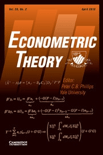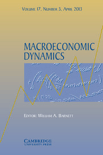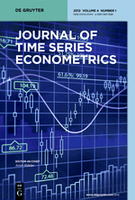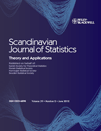
ECONOMETRIC THEORY
Scope & Guideline
Shaping the Future of Economic Research
Introduction
Aims and Scopes
- Theoretical Econometrics:
The journal emphasizes the development of new econometric theories, including asymptotic theory, identification, and estimation techniques that enhance understanding and application of statistical methods in economic contexts. - Applied Econometrics:
Articles often focus on the practical application of econometric methods to real-world economic data, providing insights into economic phenomena through rigorous statistical analysis. - Modeling Techniques:
Research includes innovative modeling techniques such as time series analysis, panel data models, and dynamic models that allow for more accurate representation of economic relationships. - Robustness and Inference:
The journal highlights the importance of robustness in econometric inference, exploring methods that ensure reliable conclusions in the presence of model uncertainties and data irregularities. - Spatial Econometrics:
There is a consistent focus on spatial econometrics, addressing issues related to spatial dependence and heterogeneity in econometric models. - Nonparametric and Semiparametric Methods:
The journal publishes research that applies nonparametric and semiparametric techniques, which are crucial for modeling complex economic relationships without imposing strict functional forms. - Treatment Effects and Causal Inference:
A significant area of research includes the analysis of treatment effects, focusing on causal inference methodologies that are vital for policy evaluation and economic research.
Trending and Emerging
- High-Dimensional Data Analysis:
Recent publications show a growing emphasis on methods for analyzing high-dimensional data, reflecting the increasing availability of large datasets and the need for robust statistical techniques to handle them. - Machine Learning Integration:
There is an emerging trend of integrating machine learning techniques with traditional econometric methods, allowing for improved predictive accuracy and model flexibility. - Causal Inference Techniques:
The importance of causal inference has surged, with a focus on methodologies that accurately estimate treatment effects and account for endogeneity in observational data. - Network Econometrics:
Research in network econometrics is gaining traction, exploring the interactions and dependencies between economic agents in network structures, which is vital for understanding complex economic systems. - Dynamic Models and Time-Varying Parameters:
An increasing number of studies are focusing on dynamic models with time-varying parameters, reflecting the need to adapt to changing economic conditions and improve model accuracy. - Robust Statistical Methods:
The development and application of robust statistical methods that withstand violations of standard assumptions are becoming more prevalent, indicating a shift towards more resilient econometric practices.
Declining or Waning
- Classical Econometric Models:
There has been a noticeable decrease in the publication of traditional econometric models, as researchers increasingly focus on more complex, modern frameworks that better account for data intricacies. - Static Models:
Static econometric models are becoming less prevalent, with a shift towards dynamic modeling approaches that better capture time-dependent behaviors in economic data. - Basic Hypothesis Testing:
Research centered on basic hypothesis testing techniques has waned, with authors favoring advanced methods that provide more nuanced insights into statistical significance and model robustness. - Univariate Time Series Analysis:
The focus on univariate time series analysis appears to be declining, as the field moves towards multivariate approaches that can account for interactions among multiple economic variables. - Traditional Regression Techniques:
There is a diminishing emphasis on conventional regression techniques, as the literature increasingly explores more sophisticated estimation methods that incorporate machine learning and high-dimensional data.
Similar Journals

MACROECONOMIC DYNAMICS
Exploring the Forces Shaping Global EconomiesMACROECONOMIC DYNAMICS, a distinguished academic journal published by Cambridge University Press, serves as a pivotal platform for innovative research in the fields of economics and econometrics. With its ISSN 1365-1005 and E-ISSN 1469-8056, the journal has been at the forefront of scholarly communication since its inception in 1997, offering an extensive range of articles that explore dynamic economic models, policy impacts, and theoretical advancements through the latest empirical analyses. Currently holding a Q2 ranking within the 2023 Economics and Econometrics category, and positioned at rank #409 out of 716 within Scopus, it is an essential resource for researchers, professionals, and students alike, looking to stay updated on critical developments in macroeconomic theory and practice. Although it follows a traditional subscription model rather than Open Access, the journal continually strives to disseminate high-quality, peer-reviewed content that informs and inspires the global economics community. The importance of MACROECONOMIC DYNAMICS lies in its commitment to fostering a deeper understanding of economic phenomena, making it a must-read for anyone engaged in the complexities of the economic landscape.

Journal of Time Series Econometrics
Elevating Econometric Practices Through Timely ResearchJournal of Time Series Econometrics, published by WALTER DE GRUYTER GMBH, serves as a pivotal platform for current research within the fields of Economics and Econometrics. With an ISSN of 2194-6507 and E-ISSN 1941-1928, this journal is dedicated to the advancement of time series analysis techniques and their practical application in economic contexts. Operating from Germany, the journal seeks to foster a vibrant intellectual environment, inviting contributions that push the boundaries of established theories and methodologies. With an established influence in academia, recent evaluations have placed the journal within the Q4 category in the 2023 rankings for Economics and Econometrics, alongside a notable 39th percentile ranking in Scopus. Although currently lacking open access options, the journal promotes crucial discussions and knowledge dissemination on innovative econometric practices. The period from 2016 to 2024 marks a significant phase of convergence in the journal's evolution, promising ongoing relevance and engagement for researchers, professionals, and students eager to explore the complexities of time series analysis and its implications within economic theory.

SCANDINAVIAN JOURNAL OF STATISTICS
Pioneering insights in the realm of statistical sciences.SCANDINAVIAN JOURNAL OF STATISTICS is a premier publication in the field of statistics, published by Wiley. With an impressive impact factor that reflects its influence, this journal is recognized for its rigorous peer-reviewed research articles that contribute to the advancement of statistical methods and their applications. As a leading resource, the journal spans a wide range of topics within Statistics and Probability, maintaining a strong scholarly presence with a Q1 rank in Statistics and Probability and a Q2 rank in Statistics, Probability and Uncertainty as per the 2023 category quartiles. The journal has been diligently publishing high-quality research since 1996, and now encompasses studies up to 2024, reinforcing its commitment to providing valuable insights for researchers, professionals, and students alike. While the journal does not offer open access, it remains an essential repository of knowledge in statistical sciences, fostering collaboration and innovation within the global academic community.

STATISTICAL PAPERS
Bridging Theory and Application in StatisticsSTATISTICAL PAPERS, published by Springer, is a leading journal in the field of Statistics and Probability that has been contributing to the academic community since 1988. With an impressive track record spanning over three decades, this journal falls within the prestigious Q2 quartile in both the Statistics and Probability and Statistics, Probability and Uncertainty categories, signifying its high-quality research output. It currently ranks #92 out of 278 in the Mathematics - Statistics and Probability category and #61 out of 168 in Decision Sciences - Statistics, Probability and Uncertainty, placing it in the 67th and 63rd percentiles respectively. Although the journal is not open access, it offers a vital platform for researchers, professionals, and students seeking to disseminate their findings and stay abreast of the latest advancements in statistical methods and applications. With its commitment to the highest standards of scholarship, STATISTICAL PAPERS plays a crucial role in shaping contemporary statistical discourse and fostering innovation within the field.

ECONOMETRICA
Unveiling the complexities of economic theory.ECONOMETRICA, published by Wiley, is a leading journal in the field of economics and econometrics, renowned for its rigorous and cutting-edge research contributions. With an ISSN of 0012-9682 and an E-ISSN of 1468-0262, this esteemed journal holds a prestigious position in the academic landscape, classified in the top quartile (Q1) for both Economics and Econometrics as of 2023, and ranked 42 out of 716 in its field, placing it in the 94th percentile according to Scopus metrics. The journal's scope encompasses a diverse range of topics aimed at advancing economic theory and its practical applications, making it an essential resource for scholars, practitioners, and students alike. Although it operates under a subscription model, the depth and quality of research published in ECONOMETRICA underscore its significance as a cornerstone for intellectual discourse and innovation within the field. Based in the United Kingdom, at 111 River St, Hoboken, NJ 07030-5774, ECONOMETRICA continues to attract high-caliber contributions that shape the future of econometric research.

CANADIAN JOURNAL OF STATISTICS-REVUE CANADIENNE DE STATISTIQUE
Exploring Innovations in Statistics and ProbabilityCanadian Journal of Statistics - Revue Canadienne de Statistique is a prestigious publication in the field of statistics, managed by Wiley. Since its inception in 1973, this journal has served as an essential resource for researchers, practitioners, and students, offering insights into a diverse range of statistical methodologies and applications. With its impact reflected in its 2023 categorization as Q2 in Statistics and Probability and Q3 in Statistics, Probability and Uncertainty, the journal stands out among its peers, exemplifying rigorous standards in empirical research. The journal's ISSN is 0319-5724 and its E-ISSN is 1708-945X, providing a robust platform for the dissemination of knowledge in the field. While it does not offer open access, the journal remains highly regarded and well-cited, contributing significantly to the advancement of statistical theory and practice. As it continues to publish cutting-edge research through to 2024, the Canadian Journal of Statistics is a must-read for anyone seeking to stay informed on the latest trends and developments in statistics.

ANNALS OF THE INSTITUTE OF STATISTICAL MATHEMATICS
Unveiling New Dimensions in Statistical ResearchANNALS OF THE INSTITUTE OF STATISTICAL MATHEMATICS, published by SPRINGER HEIDELBERG, is a prestigious academic journal that has played a pivotal role in the field of statistical mathematics since its inception in 1949. With a focus on advancing research in statistics and probability, this journal is ranked in the Q2 quartile for 2023, indicating its significance and impact within the academic community. Researchers and professionals engaged in statistical theory and methodology will find the journal's comprehensive coverage of contemporary issues essential for furthering their work and understanding of the discipline. The journal is accessible in print and digital formats, facilitating wide dissemination of knowledge among its readership. With a history of rigorous peer review and a commitment to high-quality research, the ANNALS OF THE INSTITUTE OF STATISTICAL MATHEMATICS continues to be a vital resource for academics and practitioners alike.

Econometric Reviews
Connecting Theory with Practice in Economic AnalysisEconometric Reviews, published by Taylor & Francis Inc, is a premier journal in the field of Economics and Econometrics, recognized for its significant contributions to the advancement of economic theory and practice since its inception. With its ISSN 0747-4938 and E-ISSN 1532-4168, the journal has maintained a consistent publication record from 1982 to 2024, offering a platform for groundbreaking research that shapes the landscape of quantitative economic analysis. With a proud place in the Q1 category for Economics and Econometrics as of 2023, it stands as a critical resource for scholars, practitioners, and students alike, actively engaging with themes such as econometric methods, theory, and policy implications. Although operating under a subscription model, the journal’s high impact factor reflects its esteem within the academic community, fostering a rich dialogue among researchers in this evolving discipline. The journal’s office is located at 530 Walnut Street, Ste 850, Philadelphia, PA 19106, USA, forging connections in one of the central hubs of economic research.

Central European Journal of Economic Modelling and Econometrics
Fostering global discourse in economic modeling and econometrics.Central European Journal of Economic Modelling and Econometrics (ISSN: 2080-0886, E-ISSN: 2080-119X) is a premier academic publication housed under the auspices of the Polish Academy of Sciences - Lodz Branch. Since its establishment, this journal has served as a crucial platform for scholars and practitioners alike, focusing on the dynamic realms of economic modeling and econometrics. The journal is dedicated to advancing the understanding of economic systems and statistical methodologies, striving to bridge theoretical approaches with practical applications. Although currently categorized in the Q4 quartile across various fields such as Applied Mathematics, Economics, and Statistics, its commitment to rigorous research and scholarly discourse ensures it remains an important resource for academics looking to contribute insights in these sectors. Published in Poland and featuring articles aimed at enhancing the body of knowledge in econometric modeling, this journal embraces an open-access model, allowing for greater dissemination of research findings to a global audience. Researchers, professionals, and students will find valuable contributions that not only highlight emerging trends but also foster innovation in the field of economic sciences.

Econometrics
Unlocking the Potential of Econometric MethodsEconometrics, published by MDPI, is a prominent open access journal based in Switzerland, dedicated to advancing research in the fields of economics and econometrics. Since its inception in 2013, this journal has been pivotal in disseminating innovative theories and empirical findings, fostering an engaging dialogue among scholars and practitioners. With an impressive Q2 ranking in the 2023 category of Economics and Econometrics and a solid position at #378 out of 716 in Scopus rankings, it stands as a vital resource for those seeking to enhance their understanding and application of econometric methods. The journal offers immediate open access to its published articles, ensuring that researchers, professionals, and students alike can easily access and contribute to the evolving body of knowledge in this essential discipline. The scope of Econometrics encourages submissions that cover a broad array of topics, making it a dynamic platform for innovative research until 2024 and beyond.